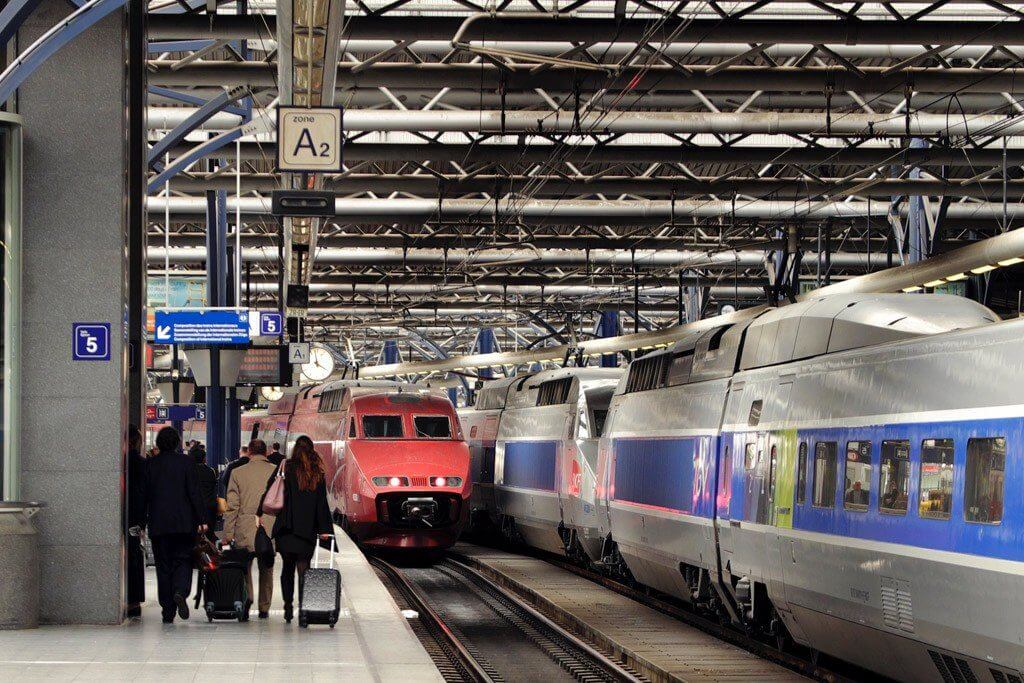Article written by Elisa
This article may contain compensated links. Please read disclaimer for more info.
Most Beautiful Cathedrals in France – 8-Day Itinerary by Train
03/10/2025Visit the Most Famous Cathedrals in France from Paris by Train
This guide offers a day-by-day itinerary for visiting the best cathedrals in France, built in the Gothic style. In a hurry? Jump directly to the itinerary overview.
France was the birthplace of Gothic architecture and has some of the oldest, most magnificent, and captivating Gothic cathedrals in the world. Each of these French Gothic cathedrals is a work of art and has its own personality, marked by exquisite carvings and spires reaching skyward.
As an architect, I love Gothic architecture, and in my opinion, no one does it better than France! For this article, I chose to go beyond a basic list of cathedrals in France by making it more personal and creating a train journey that links my favorite ones. Of course, there’s plenty of Gothic architecture in this train itinerary, but it’s not the only thing you’ll discover along the way.
Perfect for architecture enthusiasts and curious wanderers, this French Cathedrals itinerary is also one of the best train itineraries in France. First time traveling by train in France? Learn more about how it works below.
Train Trip Best Cathedrals in France – Overview
In this article, you will visit some of the best Gothic cathedrals in France by train, a curated list of 8 incredible French Gothic cathedrals (also known as Grandes Cathédrales) that represented a milestone in the development of Gothic architecture.
This train trip starts in Paris, from where you can visit the first cathedrals on the list on day trips. Then, it heads to the north to visit the French Gothic cathedrals in the Picardie region. You can take the full tour or shorten the itinerary by visiting just the first cathedrals on the list as day trips from Paris (though the ones in the Picardie region are my favorites).
- Start: Paris
- Finish: Paris
- Duration: 8 days
- Suggested Itinerary: Paris – Reims – Laon – Amiens – Rouen – Paris
- Best for: history and architecture lovers
And here’s the French Gothic Cathedrals list for this trip:
- Cathédrale Notre Dame de Paris
- Basilique-Cathédrale Saint-Denis
- Cathédrale Notre Dame de Chartres
- Cathédrale Saint-Pierre de Beauvais
- Cathédrale Notre Dame de Reims
- Cathédrale Notre Dame de Laon
- Cathédrale Notre Dame d’Amiens
- Cathédrale Notre Dame de Rouen
8-Day Best French Cathedrals Itinerary
The descriptions of the cathedrals are not super technical and easy to follow. If you are not familiar with the vocabulary related to churches and cathedrals, you may find this glossary helpful.
Day 0 | Arrival in Paris
This itinerary starts in the French capital, where you will spend at least four nights. For your stay in Paris, book a room at the Handsome Hotel by Elegancia. Located just 800 meters from the Louvre, this hotel offers great facilities and always gets the best reviews.
Day 1 | Paris and Notre Dame Cathedral
Morning on Ile de la Cité
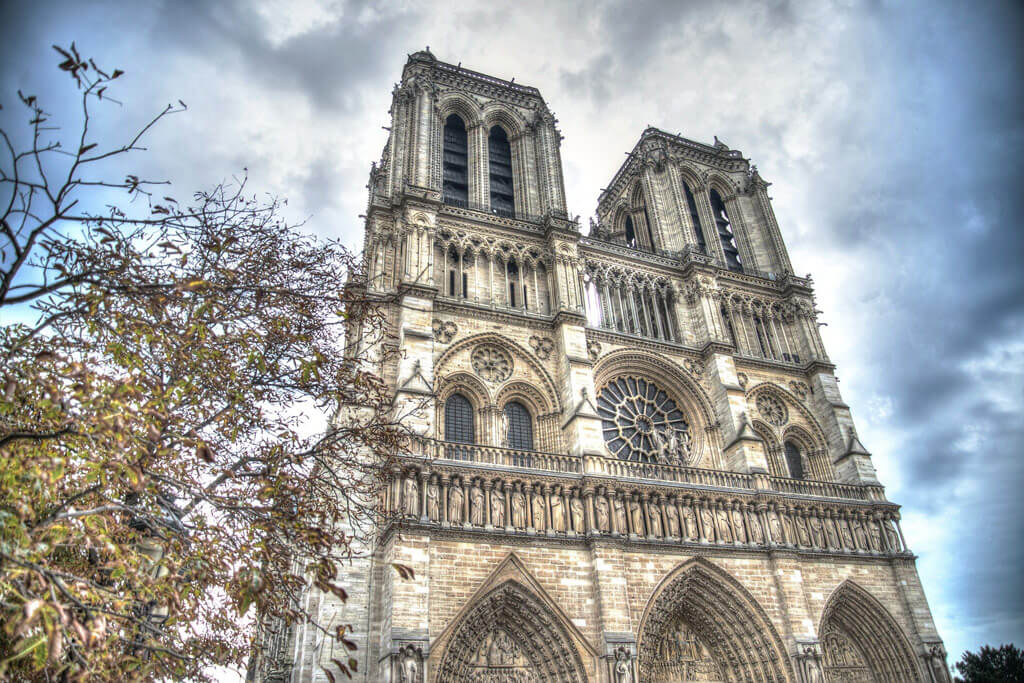
Notre Dame Cathedral is arguably the most famous cathedral in the world. This jewel of French Gothic architecture is located on Ile de la Cité, the biggest island in the River Seine in Paris. On the forecourt, a point 0 marks the start of all roads in France and is also the starting point of your train trip.
Notre Dame is one of the oldest Gothic cathedrals in France; the construction began in 1160 and was completed in 1345. Its huge flying buttresses hold up the massive structure, 130 meters long and 35 meters high (under vault), with a transept 48 meters wide. Its towers are 69 meters high, reaching into the sky and offering that superb vantage point.
On the main façade, look out for the huge rose window dedicated to Our Lady of Paris and the 28 sculptures below representing the Kings of Judah and Israel, the ancestors of Christ. These sculptures lost their heads during the French Revolution, and what you see today are replicas.
The rose window on the front above the portal measures 9.6 meters in diameter, while the two rose windows that adorn each of the arms of the transept are among the largest in Europe, with a diameter of 13 meters.
As you would no doubt be aware, Notre Dame de Paris was severely damaged during a fire in April 2019, but after extensive reconstruction works, it reopened to the public in December 2024. Now, you can also climb the towers for one of the best views of Paris! This article on the reopening of Notre Dame Cathedral shows you how to visit the cathedral and its towers (spoiler: there are already plenty of scams online, so make sure you’re booking the right thing!).
Spend the rest of the morning exploring Île de la Cité, the historic heart of medieval Paris. To experience everything this iconic island has to offer, consider taking this Île de la Cité walking tour with an expert guide. Prefer to explore on your own? Here are the best things to do on Île de la Cité.
Afternoon Visiting Paris
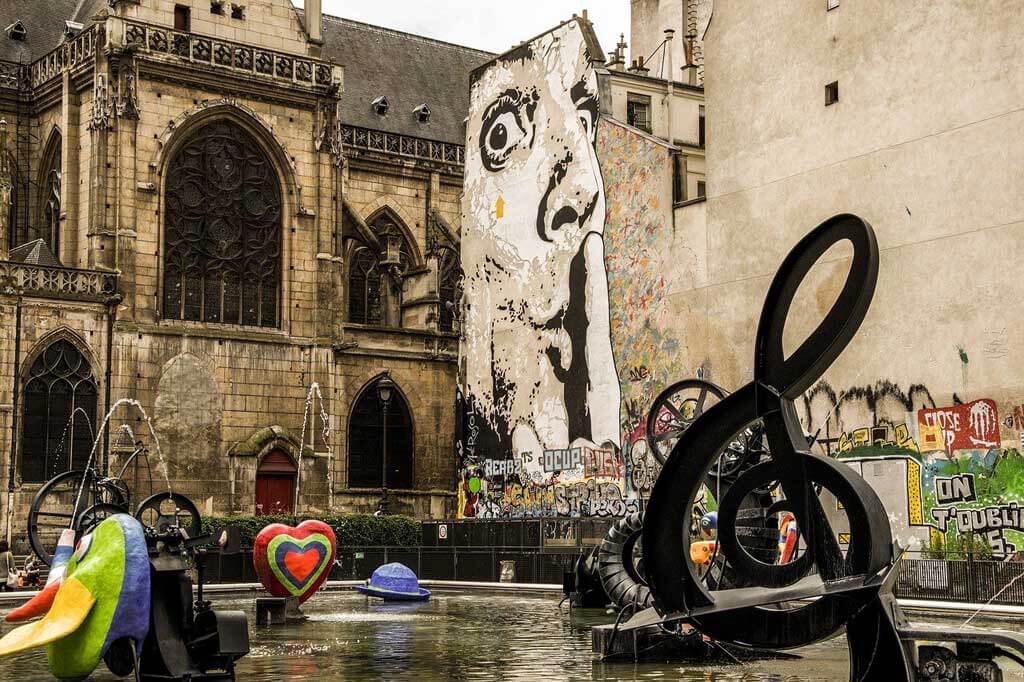
If this is your first visit to Paris, you may want to visit other Paris landmarks and neighborhoods. If you don’t know where to start, here’s my personal Paris Bucket List.
Day 2 | Basilica of Saint-Denis
Morning in Saint-Denis
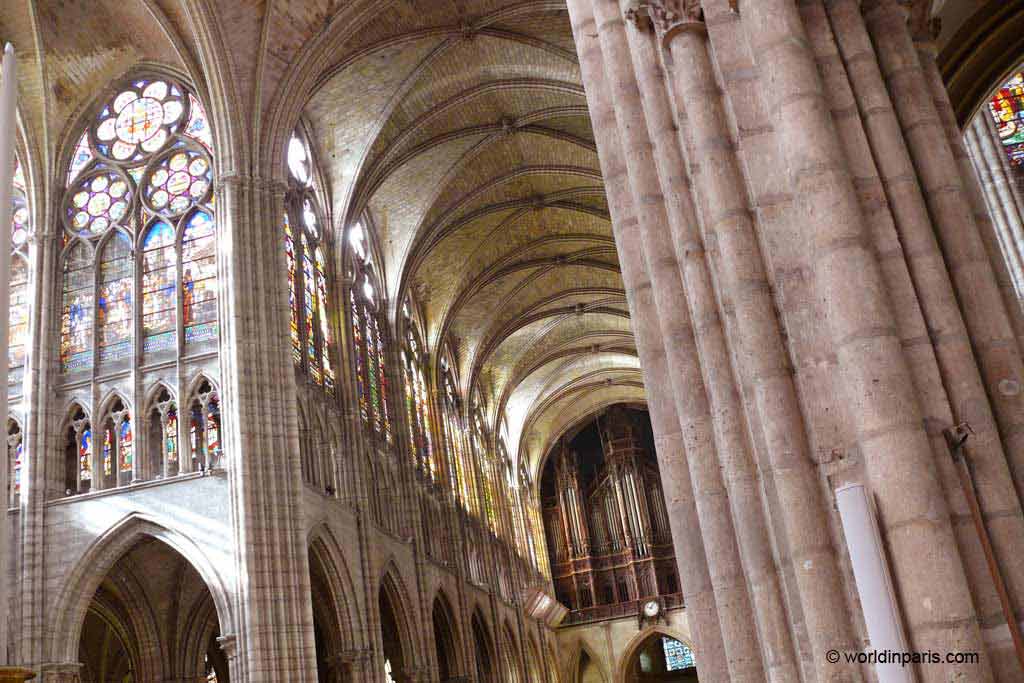
Day 2 of this French Cathedrals itinerary visits the magnificent Basilica of Saint-Denis, one of the first examples of French Gothic architecture and also the necropolis of the Kings of France. Saint-Denis is located on the outskirts of Paris, and you only need a metro ride to reach this magnificent building.
Denis was a bishop who lived in Paris in the 3rd century and was beheaded in Montmartre by the Romans who were driving out the Christians. According to the legend, the beheaded Denis would have walked from Montmartre down to Saint-Denis with his head in his hands, and the first church would have been built where Denis collapsed.
The first religious building on this site was established in the 5th century around a cemetery and the tomb of Saint-Denis, the patron saint of medieval France. Several churches succeeded the original structure, including one built around 750 by King Pépin the Short and later expanded under the Carolingians.
Between 1135 and 1144, Abbot Suger – adviser to Kings Louis VI and Louis VII – transformed the existing church by adding a grand façade with a rose window and three large portals, as well as radiating chapels in the choir. His innovative use of pointed arches, ribbed vaults, and stained glass to enhance light laid the foundation for what became known as French Gothic architecture.
The building, as it stands today, is 108 meters long and 29 meters high (under vault), with a transept 39 meters wide. The lighting is made up of more than 100 windows and 90 columns. The crypt remained Carolingian.
Another innovative Gothic element in Saint-Denis is the towers. Initially, there were two towers, but the one on the left (the tallest one) was dismantled in 1846 because it was damaged by a storm.
The Basilica of Saint-Denis is one of the most important historical sites in France, and you can purchase your entrance tickets here. Once inside, I recommend getting the audio guide to learn more about this remarkable Gothic building and the history of the kings and queens buried within.
Afternoon in Paris
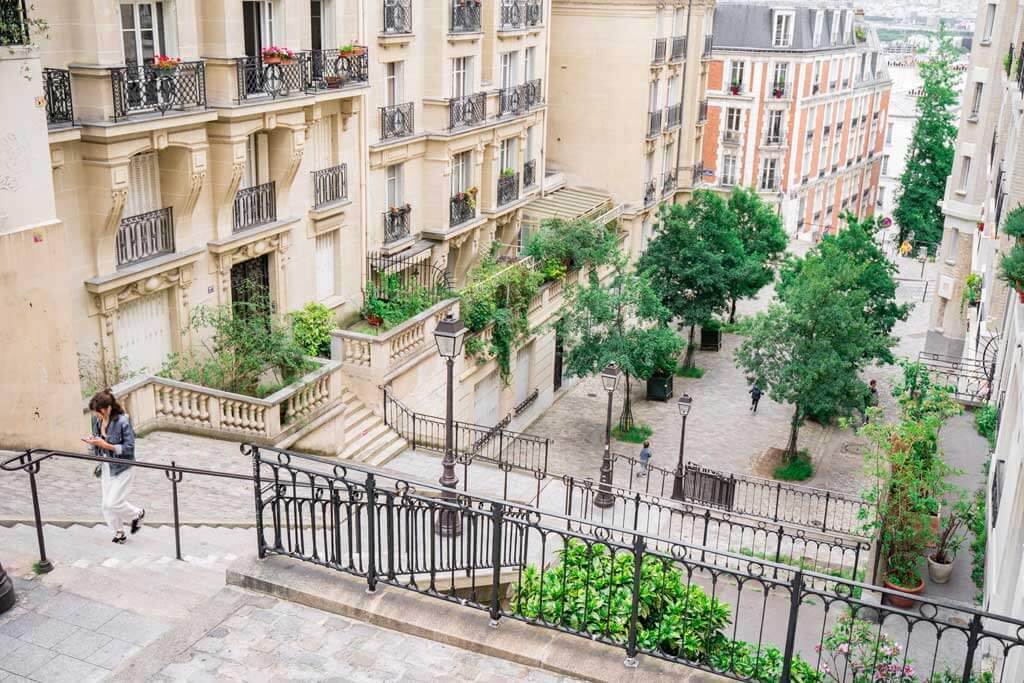
Spend the afternoon ticking off the rest of your bucket list or exploring a Paris neighborhood of your choice. If you need some help to decide, here are the best neighborhoods in Paris.
Day 3 | Day Trip to Chartres
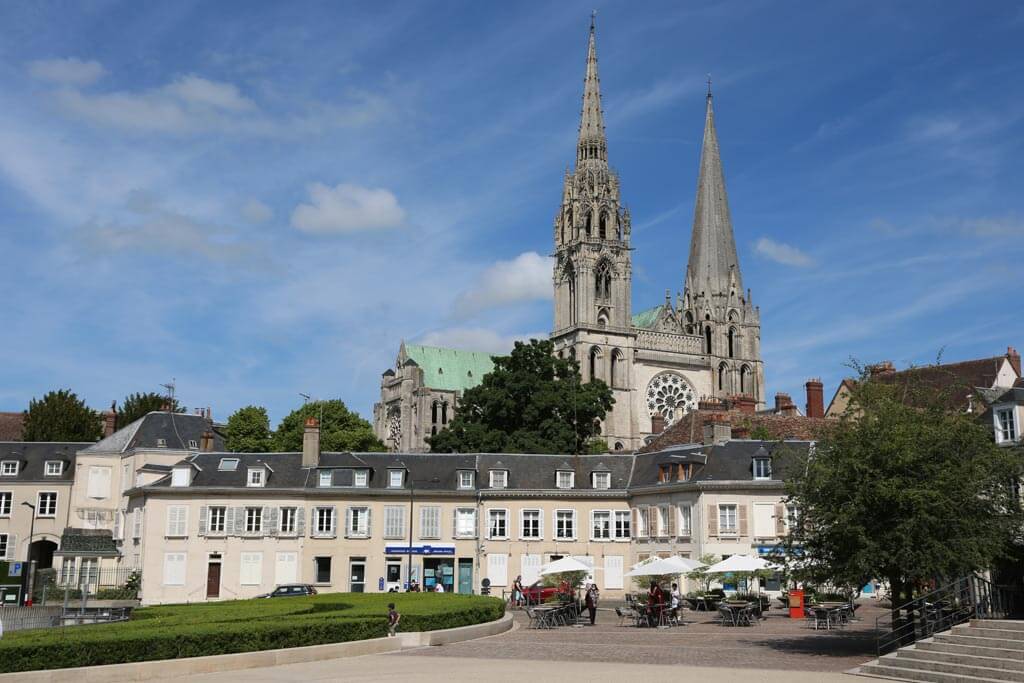
Day three of this tour around the most beautiful cathedrals in France visits Chartres, in the region of Centre-Val de Loire. Chartres is a lovely small city, easy to visit on a day trip from Paris. From Gare de Montparnasse, it’s a 1 hour 15 minutes ride to Chartres by regional train (TER) – Click here to buy your train tickets to Chartres
Notre Dame de Chartres is one of the most famous cathedrals in France, visible long before arriving in the city. Listed as a UNESCO World Heritage Site, Chartres Cathedral will dazzle you with the height of its spires, the dimensions of its nave, and its stunning stained glass windows.
The current building dates from the 13th century. Its dimensions were conditioned by the former Romanesque cathedral that occupied the site and particularly the exceptional length of its crypt: 130 meters long and 16.4 meters wide, with a transept 64 meters wide.
In medieval times, Chartres was an important religious center, with pilgrims coming from all over Europe to pay their respects to the Virgin Mary and walk through the labyrinth on the cathedral’s pavement. If possible, try to visit the cathedral on Friday when the famous labyrinth can be clearly seen.
Apart from the magnificent cathedral, Chartres has a picturesque Old Town with some timbered houses and other historical buildings. There is the Upper Town (Ville Haute) around the cathedral, while the Lower Town or Ville Basse follows the river Eure.
The list of the best things to see and do in Chartres includes:
- Maison Picassiette
- Saint-Pierre Church (10th to 13th centuries)
- Centre International du Vitrail (Stained Glass International Center)
- Maison du Saumon
Day 4 | Day Trip to Beauvais
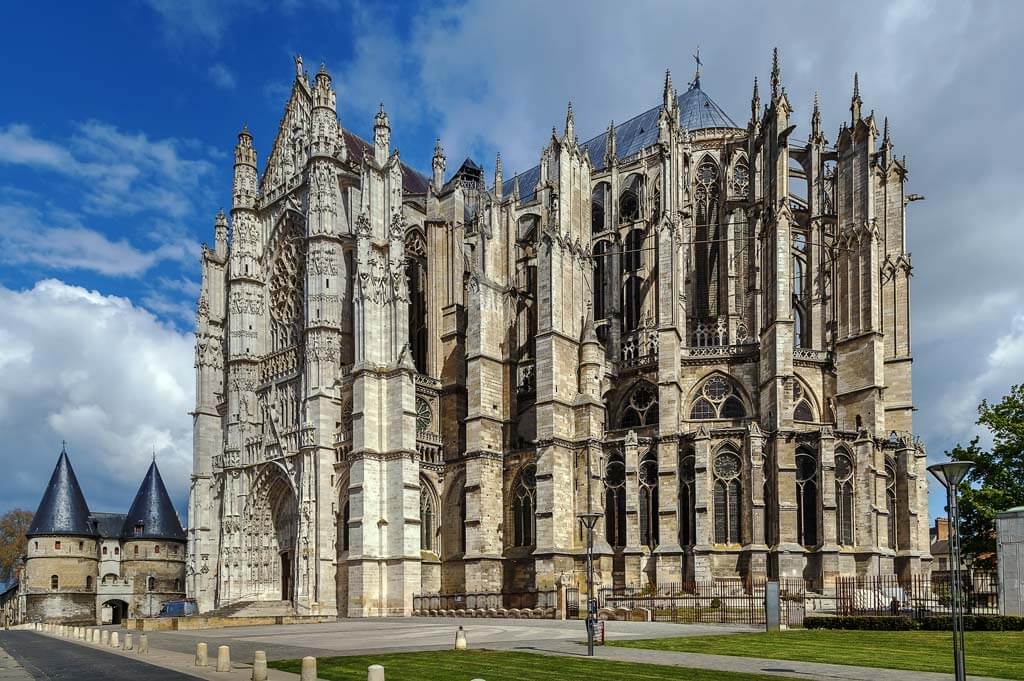
The historical region of Picardie, today part of Hauts-de-France, counts six of the best cathedrals in France. Next stop is Beauvais, where you will visit the Cathedral of Saint Pierre, the last ‘Grande Cathédrale’ to be built. The train from Paris Gare du Nord to Beauvais is direct, and takes just 1 hour 20 minutes – Click here to buy your train tickets to Beauvais
The construction of the Cathedral of Saint-Pierre began in 1225, and the design consisted of a 13th-century choir, with an apse and seven polygonal apsidal chapels reached by an ambulatory, joined to a 16th-century transept.
Saint-Pierre boasts the highest Gothic choir in the world: 48.50 m beneath the vault! Its architects aimed to build the largest Gothic cathedral in France, surpassing even Amiens. However, after two major collapses, one in the 13th century and the other in the 16th century, it remains unfinished to this day, with only the choir and the transept completed.
The remnant of the previous 10th-century Romanesque cathedral, known as the Basse Oeuvre (Lower Work), still occupies the intended site of the nave. The building, as it stands today, is 72.5 meters long and 48.5 meters high (under vault), with a transept 67.2 meters wide.
When visiting the cathedral, don’t miss its elaborate astronomical clock (1866) and its stunning collection of stained glass windows built between the 13th and 20th centuries.
Spend the rest of the day visiting the city. The list of the best things to see and do in Beauvais includes:
- Mudo – Musée d’Oise
- Saint-Etienne Church (12th to 16th century)
- Galerie National de la Tapisserie (Tapestry Factory of Beauvais)
- Maladrerie Saint Nazaire (medieval hospital for lepers)
- Plan d’Eau du Canada
Day 5 | Paris – Reims
After four days of exploring Paris and the cathedrals around, it’s time to head north. Day 5 of this Famous Cathedrals in France tour visits Reims, the capital of the Champagne region, where you will spend one night. The ride from Paris Gare de l’Est only takes 46 minutes – Click here to buy your train tickets to Reims
For your stay in Reims, book one night at Domaine Les Crayères, an iconic property set within a seven-hectare park, just 300 meters from Pommery Champagne House. Inaugurated by the Marquise de Polignac, this wonderful villa remained in her family until 1978.
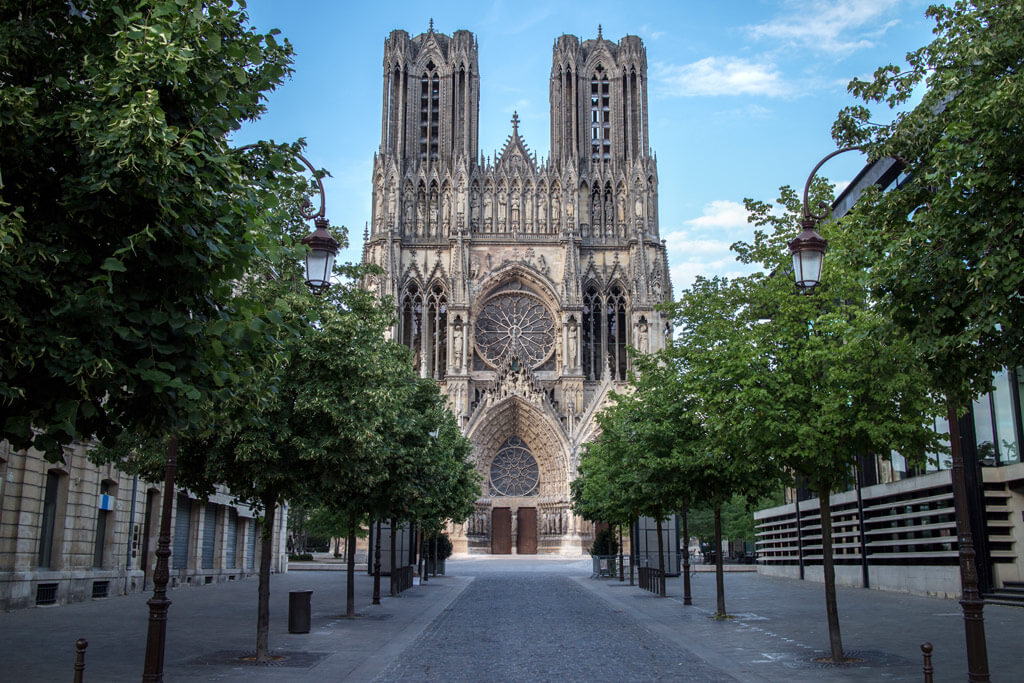
Reims is famous for its magnificent cathedral, Notre Dame de Reims, which has been listed as a UNESCO World Heritage Site since 1991. From King Clovis (6th century) to the French Revolution, all the Capetian Kings of France (with few exceptions) were crowned in this Gothic cathedral.
The construction of the current building began at the beginning of the 13th century, meaning it was built after the cathedrals in Paris and Chartres. Notre Dame de Reims is one of the major achievements of Gothic art in France, both for its architecture and for its statuary, which includes 2,303 statues.
The cathedral, as it stands today, is 149 meters long and 38 meters high (under vault), with a transept 61 meters wide. Its main facade is one of the most beautiful in France, and apart from the famous smiling angel, it is also known for its impressive Galerie des Rois de France (French Kings’ Gallery), best admired at sunset. Behind the choir, don’t miss the stained glass windows by Marc Chagall; they are stunning!
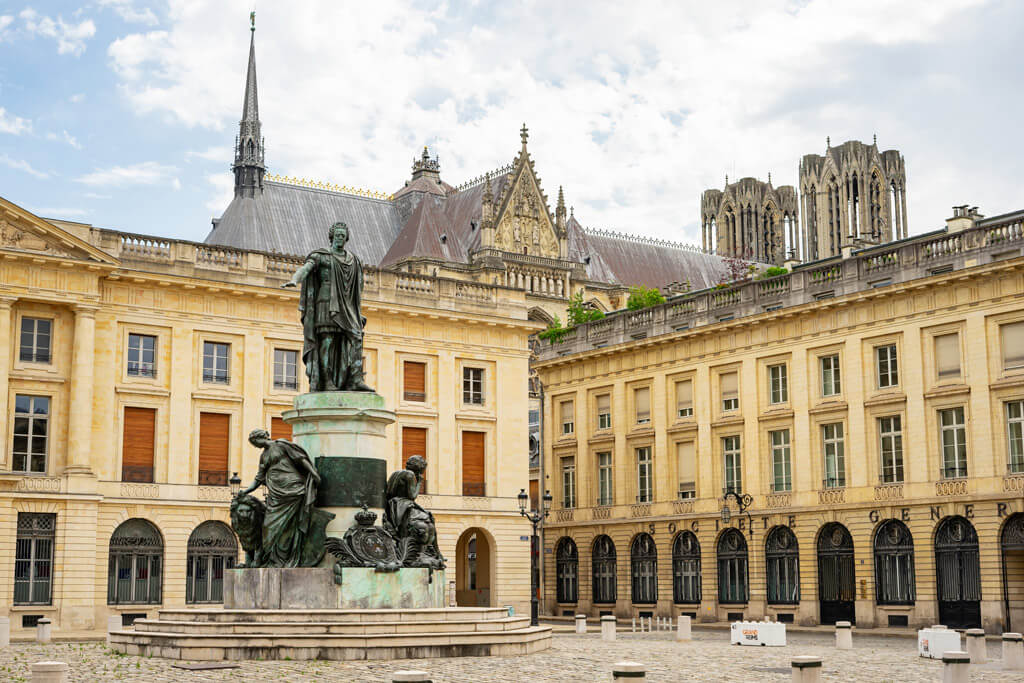
Spend the rest of the day exploring some of the best things to do in Reims. Rich in historical landmarks, the city is undeniably an important place for French history! Reims is also home to some of the best champagne houses, offering excellent champagne tours with tastings.
Day 6 | Reims – Laon
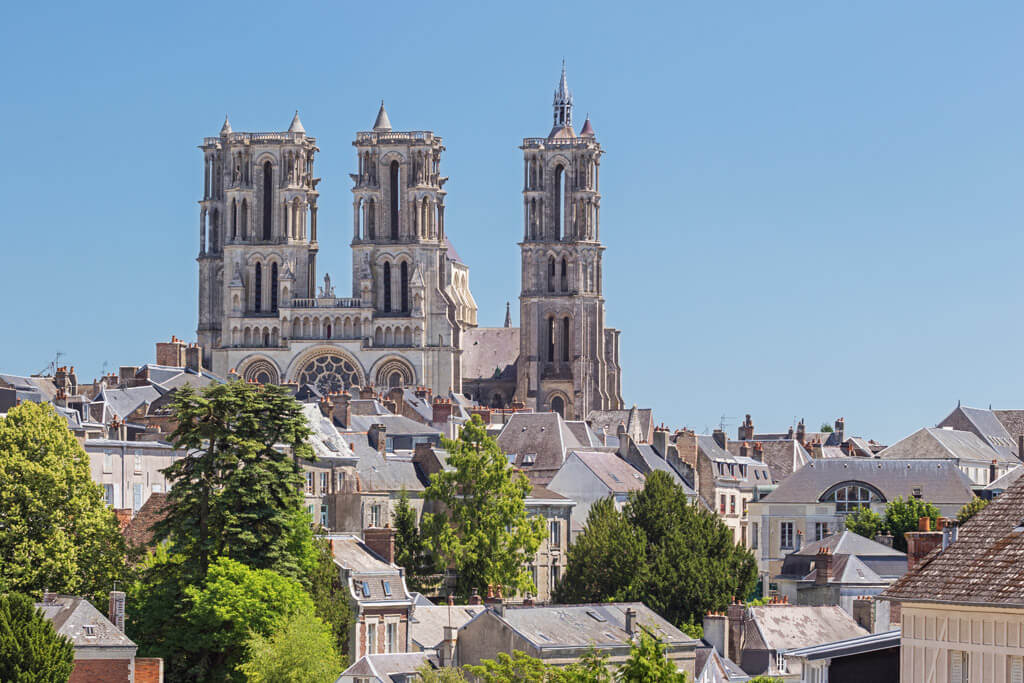
From Reims, take a regional train (TER) to Laon (pronounced “Lón”), in the Hauts-de-France region, where you will spend one night. The ride from Reims only takes 40 minutes, so if you leave early, you will have almost a whole day to visit the city – Click here to book your tickets to Laon
For your stay in Laon, book a night at the Logis du Parvis. Located in the heart of Old Laon, it has direct views of the Cathedral!
Click here to book your stay at Logis du Parvis
The train station is located in Laon’s Lower Town, which is connected to the Upper Town (the historical part) by hundreds of steps. If you are traveling with heavy suitcases, consider taking a taxi to the hotel (Upper Town).
Notre-Dame de Laon is one of the earliest French Gothic cathedrals, a remarkable example of early Gothic architecture begun around 1155. Rising above the surrounding countryside from the fortified Upper Town, the cathedral helped define the style of later Gothic cathedrals in France, including those in Reims, Chartres, and Paris.
The building, as it stands today, is modest in scale compared to the French cathedrals that followed: 110 meters long, 24 meters high (under vault), and 31 meters across the transept. It displays several hallmarks of early Gothic architecture – most noticeably, the presence of tribunes above the relatively short side aisles. The elevation is divided into four levels: the arcade, the tribune, the triforium, and the clerestory. As a result, the only direct lighting in the nave comes from the clerestory windows.
Another indication that this is a transitional cathedral is the presence of both round and pointed arches in the structure. The nave arcades are pointed (ogival), while the tribune, triforium, and clerestory arches are round.
Notre Dame de Laon has six towers (two of which are unfinished), and a lantern tower surmounts the crossing of the transept. The choir, enlarged over the centuries, does not have an apse but a back wall adorned with a large rose window that faces that of the entrance. Life-size statues of oxen adorn the towers, recalling (according to legend) the efforts these animals made to hoist the stones of the cathedral to the top of the hill.
After visiting the cathedral, get lost in the narrow medieval streets of Laon; they are full of hidden gems! The list of best things to see and do in Laon includes:
- Templars’ Chapel (12th century), under restoration in 2022 when I visited the last time
- Musée d’Art et d’Archéologie
- Laon’s Ramparts
- Porte d’Ardon, Porte de Soissons
- Ancien Hotel-Dieu (currently the Tourism Office)
- Saint-Martin Church
- Underground Laon (with a guided tour, booked at the Tourism Office)
- Episcopal Palace
- Batterie Morlot (part of Laon’s defenses)
Day 7 | Laon – Amiens
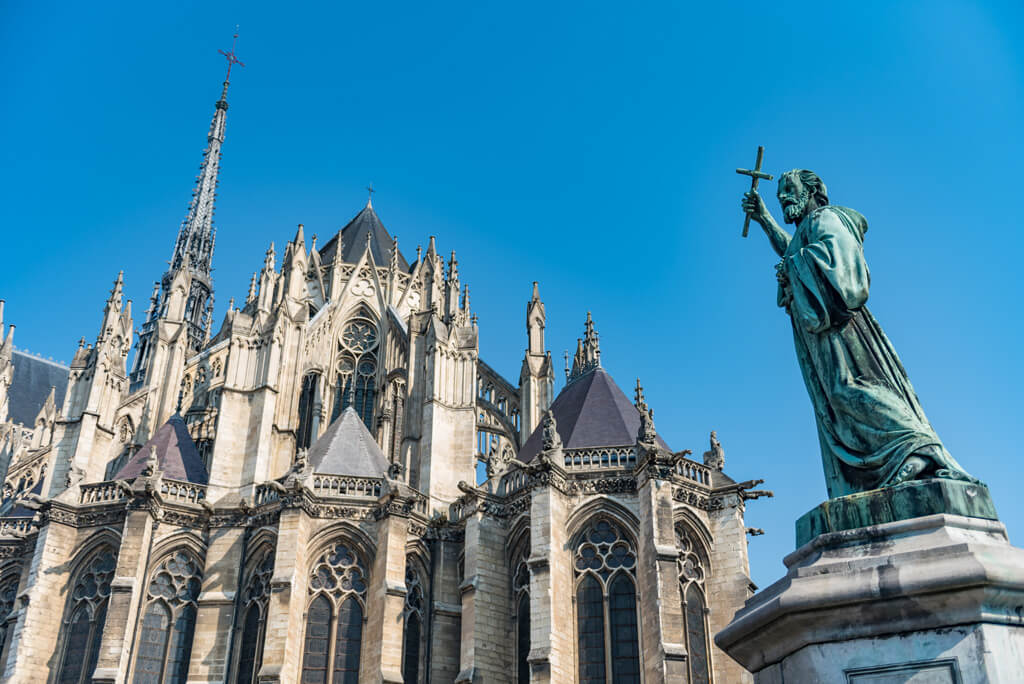
Day 7 of this Best Cathedrals in France itinerary visits Amiens, where you will spend one night. Trains from Laon to Amiens depart early in the morning and late in the afternoon, so it is well worth waking up with the sun to catch one of the morning trains – Click here to book your train tickets to Amiens
For your stay in Amiens, book one night at Hotel Le Prieuré. Located at the foot of the cathedral, some of the rooms have direct views of the impressive Gothic building.
Notre Dame d’Amiens is the world’s biggest Gothic cathedral. With a volume of 200,000m3, it could fit two Notre Dames of Paris inside! Built between 12020 and 1288, Amiens is a symbol of the classic Gothic style for the nave and the radiant choir. The flamboyant Gothic style is present in the rose windows of the western façade and of the transept, the upper parts of the north tower, the Beau Pilier, the stalls, and the statuary of the enclosure of the choir.
The building, as it stands today, is 145 meters long and 42,3 meters high (under vault), with a transept 70 meters wide. The cathedral has lost most of its original stained-glass windows, but it remains renowned for its 13th-century Gothic carvings adorning its facades, as well as the choir stalls inside, made in the early 16th century and remarkably intact.
Spend the rest of the day visiting Amiens, one of the most beautiful cities in Northern France. This lovely place is also known for being home to Jules Verne (the famous French writer), and its floating gardens or hortillonnages, unique in France. If you need some guidance for your visit, here are the best things to do in Amiens.
Day 8 | Amiens – Rouen – Paris
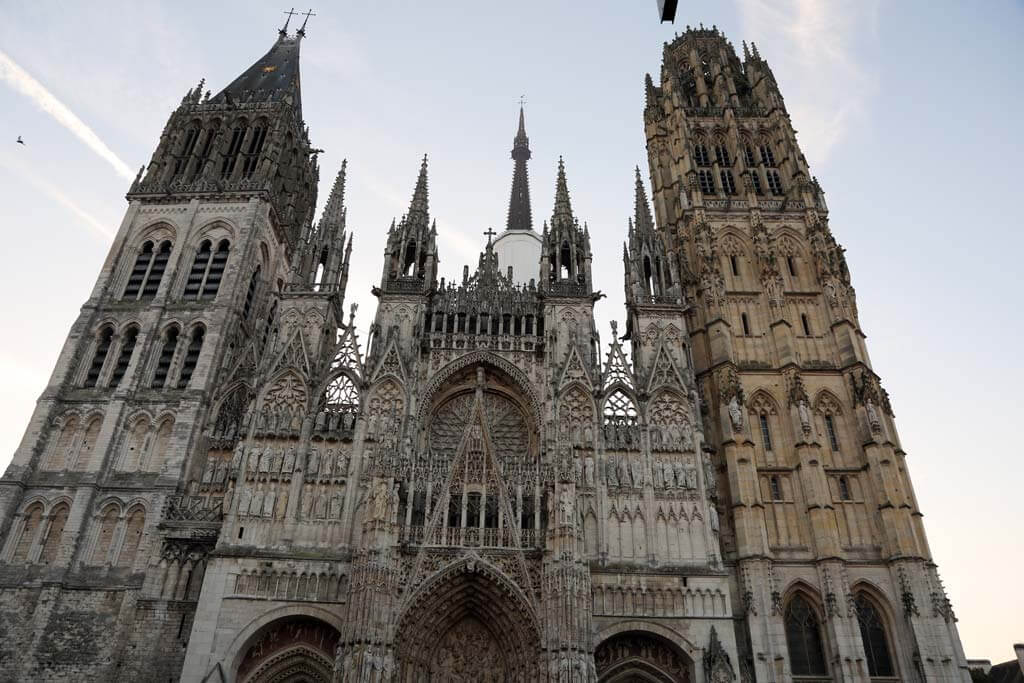
The last day of this train itinerary explores Rouen in Normandy. From Amiens, the train to Rouen only takes 1 hour 30 minutes – Click here to book your train tickets to Rouen
Notre Dame de Rouen Cathedral is the city’s most important monument. The huge towers of the cathedral announce the city from afar. One of the Grandes Cathédrales of France, Notre Dame de Rouen is a masterwork of French Gothic architecture, with elements from early Gothic to Gothic Flamboyant.
The works to build the Gothic cathedral started in 1145 on the foundations of a 4th-century basilica and an 11th-century Romanesque cathedral, of which the crypt has been preserved. A hundred years later, it was complete, but it was remodeled over the following centuries.
The building, as it stands today, is 136.86 meters long and 28 meters high (under vault), with a transept 57 meters wide. The facade represents a precious testimony to the evolution of Gothic art from the middle of the 12th century to the beginning of the 16th century. In the 19th century, the pretty lantern tower received a cast-iron spire that rises to 151 meters, the highest in France!
The choir of the cathedral houses the tombs of the Dukes of Normandy, including Rollo, founder of the duchy in 911, as well as the heart of Richard Cœur de Lion, King of England and Duke of Normandy.
In the early 1890s, Notre Dame de Rouen was the model for some of Monet’s masterworks. The different paintings (30) depicted the cathedral in different lights and weather, showing Monet’s fascination with the effects of light. On the cathedral’s forecourt, visitors can still see the exact spot where Monet set his easel to paint the cathedral.
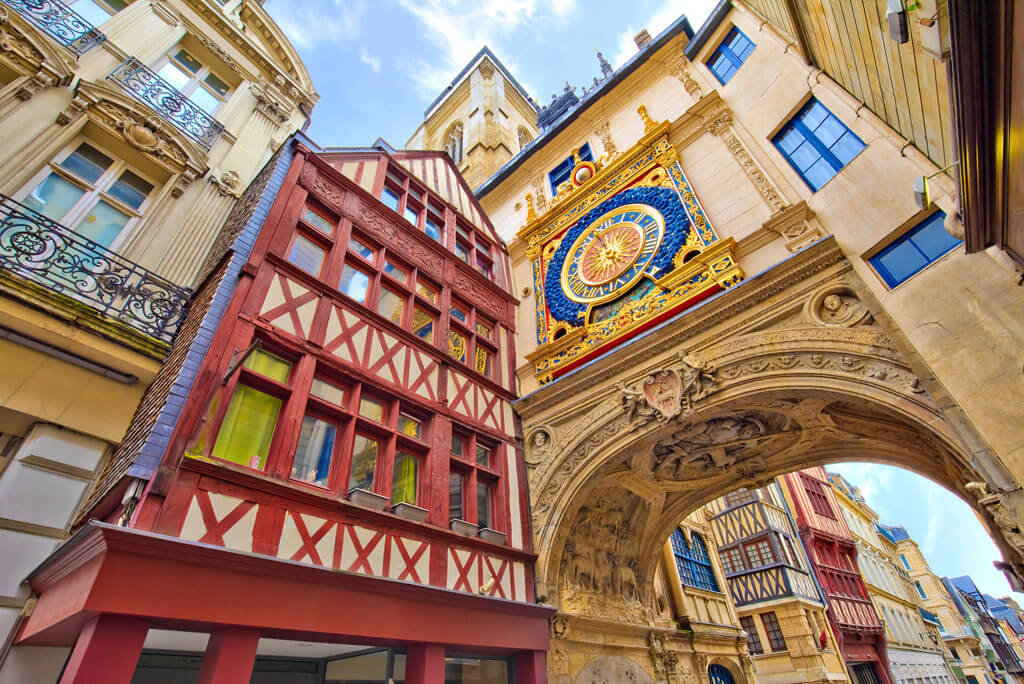
Before leaving Rouen, take the time to explore the city. Nicknamed ‘the city of 100 bell towers,’ which dominate the city’s skyline, Rouen boasts the best-preserved medieval center in all of France, with beautiful architecture. To optimize your time in the city, here are the best things to do in Rouen.
This train trip in France ends here. From Rouen, the train to Paris Saint-Lazare only takes 1 hr 30 min – Click here to book your train tickets to Paris


